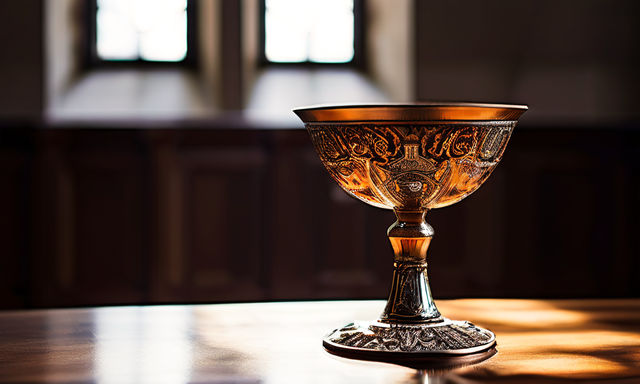
A Tapestry of Faith: Exploring Different Types of Church Articles
|
|
Time to read 6 min
|
|
Time to read 6 min
Churches, synagogues, mosques, and temples – these places of worship hold immense significance for people of faith. Beyond the spiritual sanctuary they provide, these spaces are often adorned with symbolic objects that enhance the experience of devotion. In Christianity, a rich tradition of church articles exists, each piece serving a specific purpose and steeped in history and meaning. Let's delve into this tapestry of faith, exploring the different types of church articles, their biblical references, and the craftsmanship behind their creation.
Biblical References: Exodus 28:2-4, Revelation 1:13
Clergy attire, known as vestments, plays a central role in Christian liturgy. The roots of this tradition can be traced back to the elaborate garments worn by priests in the Hebrew Temple, as detailed in Exodus [Exodus 28:2-4]. These garments served to distinguish the priests from the laity and symbolize the holiness of their office. In the New Testament, while specific vestments aren't mandated, Revelation offers a glimpse of heavenly beings adorned in white robes [Revelation 1:13], which later influenced Christian clerical attire.
Types of Vestments:
Crafting Vestments: Traditionally, vestments are handcrafted by skilled artisans using rich fabrics like silk, brocade, and damask. Symbolic embroidery, often depicting biblical scenes or saints, adds another layer of meaning. Today, a balance exists between machine-made and hand-crafted pieces, with many churches opting for a combination depending on budget and desired level of detail.
Biblical References: Matthew 26:27-29, Mark 14:22-24
Central to the celebration of the Eucharist are vessels used for the bread and wine. The chalice, a footed cup, holds the consecrated wine, symbolizing the blood of Christ. The paten, a flat plate, holds the bread before consecration, representing the body of Christ. These references can be linked to the Last Supper, where Jesus shared bread and wine with his disciples [Matthew 26:27-29, Mark 14:22-24].
Additional Vessels:
Crafting Vessels: The materials used for these vessels vary widely. They can be crafted from precious metals like gold and silver, or more modest materials like brass or pewter. Ornate engravings and depictions of the Eucharist or biblical scenes are often featured. Skilled metalworkers meticulously create these vessels, ensuring their durability and symbolic significance.
Biblical References: Matthew 5:14-16, John 8:12
Light plays a crucial role in Christian symbolism, representing God's presence and guidance. Candles feature prominently in church ceremonies, symbolizing Jesus as the "light of the world" [John 8:12]. The placement of candles on the altar during Mass reflects this concept.
Types of Church Lighting:
Crafting Church Lighting: Candles used in church ceremonies are typically made from beeswax, considered a pure and natural material. Candelabra and sanctuary lamps can be crafted from various materials like metal, glass, or even wood. The design can be simple or ornate, depending on the desired aesthetic of the church.
Biblical References: Exodus 20:4, Deuteronomy 4:15-18
While some Christian denominations frown upon the use of religious imagery,
Types of Religious Imagery:
Additional Sacred Space Adornments:
Crafting Religious Imagery and Sacred Space Adornments: Artists skilled in sculpture and painting create statues and paintings. For statues, the process may involve carving wood or stone, or metalworking techniques like casting or welding. Painters utilize various techniques like oil, fresco, or tempera on canvas or directly on the church walls. Craftspeople specializing in metalwork and religious iconography create tabernacles and monstrances. The level of detail and ornamentation varies depending on the budget and desired artistic expression.
Biblical References: Numbers 10:1-10
Bells have long been used as a call to prayer and worship. In the Old Testament, the Book of Numbers describes the use of silver trumpets to summon the Israelites [Numbers 10:1-10]. While trumpets are less common today, bells continue to play a vital role in Christian worship.
Types of Church Bells:
Crafting Church Bells: Bell founders, skilled artisans with a knowledge of metallurgy and acoustics, create church bells. The size and thickness of the bell, along with the composition of the metal alloy, determine its pitch and sound. Traditional methods involve casting molten metal into a mold and then allowing it to cool and solidify.
Church articles are more than just decorative elements. They are tangible expressions of faith, serving as visual aids, catalysts for devotion, and reminders of core Christian beliefs. From the simple beeswax candle to the intricately carved statue, each piece contributes to the unique atmosphere of a church, fostering a deeper connection between the faithful and the divine. Understanding the history, symbolism, and craftsmanship behind these articles enriches our appreciation for the rich tapestry of Christian tradition.